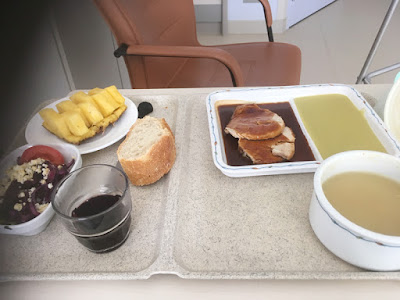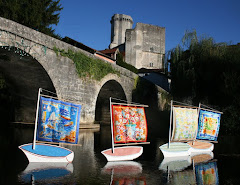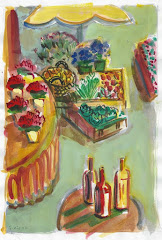Friday, January 25, 2019
Hacking Back Trees
The other day the town maintenance crew was out doing their annual hacking back of the village trees. For years I have wondered why they do this. Sometimes it’s obvious, the cutting back creates a denser summer canopy, but for a lot of the trees it just seems like a lot of effort to leave us with ugly stumps for half of the year. Asking around for an explanation I’ve gotten vague answers, but nothing stated with confidence. The weekend after the gang was out there hacking away there was a short two page article in the Saturday Magazine explaining the historical background of this practice. Oh how I love the esoteric topics that come up in that Saturday journal.
Here’s the scoop.
The practice of lopping off the top of trees can be traced all the way back to the neolithic period in Great Britain. With a lot of time on their hands and few mechanical resources, folks figured out it was easier and more efficient to prune the trees around them, but not cut them down. By doing this the crown of the tree would come back fuller the following year and the yearling branches would be the perfect size and flexibility for weaving material. Remember at that time homes, roofs, fencing, and other stuff were built out of sticks. The scraps of cuttings made good forage for their farm animals. The best part was that they could count on the same crop the following year. They didn’t have to lug trees from further and further from home and they didn’t have to wait years for seedlings to grow.
In the Middle Ages the practice spread to Europe (goodness knows how historians can trace these sorts of agricultural migrations). Life continued to be hard, physical labor was cheap, and cutting back tree crowns was a handy, efficient renewable resource. Pruning could even make the trees healthier and more productive. Depending on the type of tree and how often the tree was pruned you could arrive with different results. Cutting a weeping willow or a mulberry tree every two to three years you got branches for weaving, food for the animals, and cuttings to plant for hedges. If you extended the pruning to every three to ten years the trees would be stimulated to produce more fruits (chestnuts, acorns). For the truly patient, a pruning between ten to twenty years would produce renewable wood for firewood and roofing. All of this without killing the tree. These trees were almost immortal. Well, immortal might be a tiny bit exaggerated, but by cutting a tree regularly one might triple the life expectancy of the tree. One thing that helped prolong their lives was that by never having a great canopy the risk of wind damage was diminished. (This fear of trees being toppled by the wind seems to be the only part of the history that remains imprinted in most of our neighbor’s feelings about trees. Even the insurance agency comes out to your home to inspect if there are any un-cutback trees too near to your house.)
Throughout Europe forest were managed in this style of severe pruning. Just south of us in the department of Sare (think Spanish border) there are the remnants of one such ancient “wood farm”. In the 1600’s two things came together that initiated the creation of this particular forest. The first was the need for wood to create coal for the local forgeries. The second was the need for forage to feed the large sheep and pig herds. The two industries worked hand in hand using every bit of cut wood. But by the mid 1800’s with more industrial techniques available forest management changed. Fast, tree gobbling clear cutting became the fashion to feed the growing demands of the industrial age. Somehow the locals of Sare were able to save the 42,000 trees in their forest from the chainsaw. However having escaped technology many of the trees were killed off in1906 by the same mildew that killed off the vineyards of France. Eventually the forest was left neglected and unproductive. Today there is a small association working to maintain this rare historical vestige of the 15,000 trees that remain. This association has dreams of reviving the old practices of the renewable forest farm.
Back in Bourdeilles the days are long gone when folks filled their winter days doing labor that was necessary for their survival. No one is counting on woven tree branches for a roof or fencing. Hardly anyone keeps farm animals and those that do have industrial sources of animal food. Yet, somehow keeping neighborhood trees pruned rests deep in the psyche of the villagers. So much so that they don’t even question the expense, time and effort of the town maintenance crew. Most folks couldn’t imagine having the trees with branches reaching for the sky. That big tree canopy would block the view or catch the wind and fall on the house. Walking the streets on these grey winter days I appreciate how the strength of these gnarled trees compliments the power of the stone of our small village in France. So, for this particular quirk of culture, I can now stop questioning and just accept it as a tradition — like a local.
Monday, January 14, 2019
Red Wine and an Operation
Pain and immobility were getting me down.
The good news is that all is done and dusted. The bad news was that in order to jump back into life at the pace I like I needed a new hip. Oh! lLa La! I was going to get a french hip!
It took a while to navigate through the system of referring doctors, but once I saw the specialist there was no question that the hip I had was kaput. I liked the surgeon’s professional yet warm demeanor, his clear explication of the situation and his display of diplomas and certifications. Right away I had confidence in him and his qualifications.
Unbeknownst to me I could have had several choices of a surgeon and three choices of hospitals. Seemingly I had landed in the right place, but how was I to be sure…
The very first French person that I told I was going to have surgery asked, “Where?” When I said the Clinique du Parc their eyes lit up and they said “Oh that’s so good. They serve wine with your meals.”
What? Not, “you have the best surgeon, the hospital with the best rating, a gentle caring staff.” Nope, I’m in France and choices are made on the finer things in life.
To a person the first comment everyone made was, “They serve wine with your meals”. Second, “They have a private chef and you eat really well”. Last, but not least to me, “Oh the surgeon is Dr Hossenbachus. I’ve heard he’s good”. I started to think I’d stay in a drunken haze and hope the rest worked out.
The day arrived and I checked into my private room (50 euros per night) and settled in. At 6:00 pm. on the dot dinner arrived. It smelled good and I wondered what was under the lids. Before I could peek the nurse popped in and asked would I like wine with dinner? It was true, alcohol in a hospital! Should I ask for red or white? What was I having to eat? How silly of me - the choice was red wine or red wine. “Of course I’ll have some wine, you know, just to calm the nerves.”
So there I was with my glass of red wine, a beautifully prepared fish and lots of vegetables. The starter was a broth. There was chocolate mousse waiting for dessert. I was starting to see what all the excitement was about with the food at La Clinique du Parc.
The morning of the operation was less exciting. I was given a little juice to hold me over. (What, no mimosa?) As soon as I woke up after the operation there was a little apple sauce.
Only a few hours later it was 6:00 PM sharp and there was my dinner tray. Surprised to be coherent enough to eat I gobbled up a delicious broiled cheese fennel and a slice of pizza. I could only muster up enthusiasm for a few spoonfuls of broth. Woe is me, wine is not offered for the post-op dinner.
Every breakfast was the same, a roll, butter, frommage blanc, and tea.
On the morning of Day 2 someone arrived in my room and said they were here to “propose” to me the day’s choices for meals. I quickly realized I wasn't really being given choices as much as an announcement. No problem, the day’s proposal sounded delicious and yes I would like all of that.
Lunch was pork cutlets and pureed peas. The fresh pineapple was a treat. Yippee! The red wine was back! Even at lunch!
Dinner was paupiette de veau, cheesy broiled endive, broth, and more wine.
On Day 3 I liked the proposed meal for lunch. But my ears took a double take when they said it was boudin noir for dinner. (Black blood sausage - I don’t think so!)
By lunchtime the drugs were starting to wear off and the thought of a glass of wine was not very appealing. The nurse was a bit surprised when she entered with a nice Bordeaux and I declined her kind offer. The crisp, tangy endive salad was delicious. I couldn’t eat another spoonful of broth. The fish was tasty, but oh all that creamy sauce. The mountain of spinach covered in cheese was doing me in. And this was just lunch time.
I had to laugh when dinner came. Having rejected the boudin noir the main course section of the meal-tray was empty. On a side plate there was a cold slice of ham tightly wrapped up in plastic. There were cheesy mashed potatoes and broth. Even without the black blood sausage this French food was going to kill me.
It was time to go home. No more fancy sauces and no more mushy, cheesy vegetables. That last morning I couldn’t even be bothered with the roll. “Two teas please.”
I appreciate the French holding onto their standards to the finer things in life even when in the hospital, but for me, in the end, even the wine took a back seat to my excellent surgeon and the fine care I received. I had landed in the right hands and was thankful to be going home to the rhythm of my still mostly American eating habits - with a daily dose of French wine of course.
I appreciate the French holding onto their standards to the finer things in life even when in the hospital, but for me, in the end, even the wine took a back seat to my excellent surgeon and the fine care I received. I had landed in the right hands and was thankful to be going home to the rhythm of my still mostly American eating habits - with a daily dose of French wine of course.
Tuesday, January 1, 2019
Happy New Year - Keeping it Simple
I learn my best french from children's books.
This dictionary page seems to have the perfect vocabulary to start off 2019.
A Happy Life
Love, friendship and respect of others brings happiness to all. You can show your feelings in a number of ways. A hug, a kiss, a smile, praise, or a handshake, are all gestures that can make people happy.
Happy New Year to you one and all!
Subscribe to:
Posts (Atom)



























